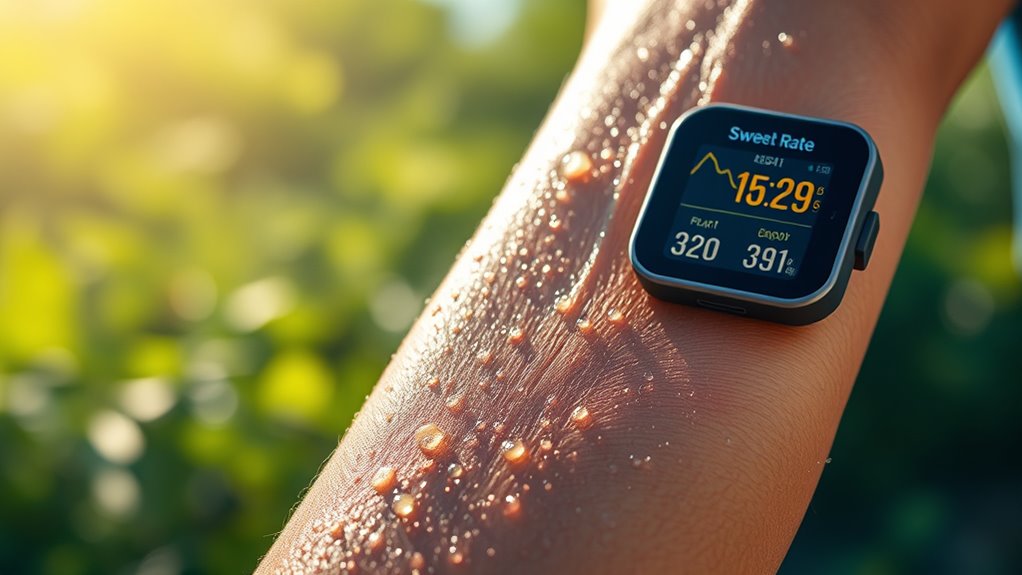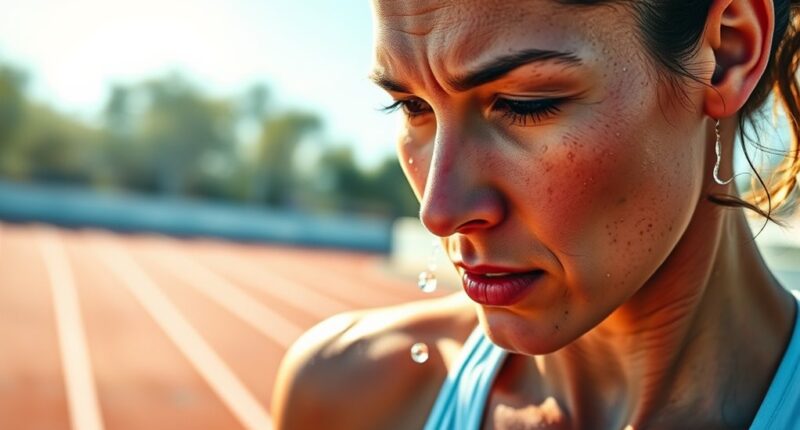To calculate your sweat rate, weigh yourself before and after exercise, ensuring you’ve emptied your bladder and worn similar clothing. The weight lost mainly reflects fluid loss, so each pound equals about 16 ounces of sweat. Divide the weight loss by the exercise duration to find your hourly sweat rate. Understanding this helps you customize hydration, balancing water and electrolytes effectively. Keep going, and you’ll discover how to fine-tune your hydration plan for better performance and health.
Key Takeaways
- Measure pre- and post-exercise body weight with minimal clothing to determine fluid loss.
- Subtract post-exercise weight from pre-exercise weight to find total weight loss.
- Convert weight loss (pounds) to fluid volume by multiplying by 16 ounces (half-liter).
- Divide total fluid loss by exercise duration to calculate hourly sweat rate.
- Use sweat rate data to optimize hydration strategies and electrolyte replacement during activity.

Have you ever wondered why staying properly hydrated is essential for your health? When you’re active, your body loses fluids through sweat, and if you don’t replace these adequately, it can throw off your electrolyte balance. Electrolytes like sodium, potassium, and chloride are fundamental for nerve function, muscle contractions, and maintaining overall cellular function. When your electrolyte levels become imbalanced, you might start noticing dehydration symptoms such as dry mouth, fatigue, dizziness, or muscle cramps. Recognizing these signs early helps you take the right steps to rehydrate and restore balance before more serious issues develop.
Proper hydration maintains electrolyte balance and prevents dehydration symptoms like fatigue and cramps.
Understanding your sweat rate is critical because it helps you determine how much fluid you need to drink during physical activity. Your sweat rate varies based on factors like temperature, humidity, intensity, and individual physiology. To calculate it, you can start by weighing yourself before and after exercise, making sure to empty your bladder beforehand and avoid clothing that traps heat or sweat. After your workout, dry off, then weigh yourself again. The difference in weight primarily reflects fluid loss. Remember, each pound lost equals approximately 16 ounces (or half a liter) of fluid. Additionally, factors like hormonal regulation can influence how much you sweat and how your body manages fluid balance.
Once you know how much weight you’ve lost, you can estimate your sweat rate by dividing that number by the duration of your activity in hours. For example, if you lose two pounds during an hour-long workout, your sweat rate is about 32 ounces per hour. This information helps you tailor your hydration strategy, ensuring you’re drinking enough water or electrolyte drinks to compensate for losses. It’s also wise to monitor how you feel during exercise—if you notice symptoms like excessive thirst, weakness, or confusion, you might be dehydrated even if your weight loss isn’t drastic.
Paying attention to hydration and electrolyte balance is especially critical during intense or prolonged activities, as dehydration symptoms can escalate quickly. Proper hydration not only prevents discomfort but also optimizes performance and recovery. If you’re exercising in hot or humid conditions, your sweat rate will likely increase, making it even more important to hydrate effectively. Remember, drinking too little can lead to dehydration, while overhydrating with plain water in a short period might dilute electrolytes, leading to hyponatremia, which is dangerous. Striking the right balance involves understanding your personal sweat rate, listening to your body’s signals, and adjusting your fluid intake accordingly.
Frequently Asked Questions
How Does Ambient Temperature Affect Sweat Rate Calculations?
Ambient temperature directly impacts your sweat rate calculations because higher temperatures increase your body’s need to cool down through sweat evaporation. As it gets hotter, you’ll sweat more, making your sweat rate higher. Conversely, cooler temperatures reduce sweat production. When calculating sweat rate, consider ambient temperature because it influences how much you sweat and how effectively sweat evaporates, affecting your overall hydration needs during physical activity.
Can Hydration Needs Vary Based on Individual Fitness Levels?
Your hydration needs definitely vary based on your fitness influence. As you become more fit, your body adapts to efficiently manage fluids and electrolytes, often reducing your sweat rate. Personalized hydration is key because your workout intensity, duration, and overall fitness level impact how much water you lose. By paying attention to these factors, you can better tailor your hydration strategies to stay properly fueled and avoid dehydration during physical activity.
What Role Does Electrolyte Balance Play in Hydration Science?
Imagine your body as a delicate balance beam, where electrolyte balance acts as the tightrope walker. Electrolyte replenishment guarantees your muscles and nerves function smoothly, preventing cramps and fatigue. Proper fluid absorption relies on this balance, allowing hydration to reach cells efficiently. When electrolytes are in harmony, your body stays energized and resilient, making hydration science a crucial part of your overall health and performance.
How Accurate Are Wearable Devices for Measuring Sweat Rate?
Wearable devices for measuring sweat rate can be fairly accurate, but their sensor accuracy depends heavily on proper data calibration. You should regularly calibrate these devices to guarantee precise readings, especially during intense activities. Keep in mind that factors like skin type, temperature, and device placement can affect results. While they provide useful estimates, always consider calibration and environmental influences for the most reliable sweat rate measurements.
Does Hydration Strategy Differ for Different Sports or Activities?
Your hydration strategy should differ based on the sport or activity you’re doing. For endurance sports, focus on hydration timing, drinking fluids before, during, and after to maintain fluid absorption and prevent dehydration. In high-intensity activities, more frequent, smaller sips help optimize fluid intake without stomach upset. Tailoring your hydration plan to the activity guarantees you stay properly hydrated, maximizing performance and recovery.
Conclusion
Mastering sweat rate calculation isn’t just a skill—it’s your secret weapon against dehydration’s sneaky attacks! Imagine losing enough fluid to turn a small pond into a dry desert—every drop counts! By understanding your sweat rate, you can crush dehydration and stay unstoppable. Don’t let your body become a barren wasteland; take control now and hydrate like a hero. Your performance depends on it—stay ahead, stay hydrated, and conquer every challenge that comes your way!









